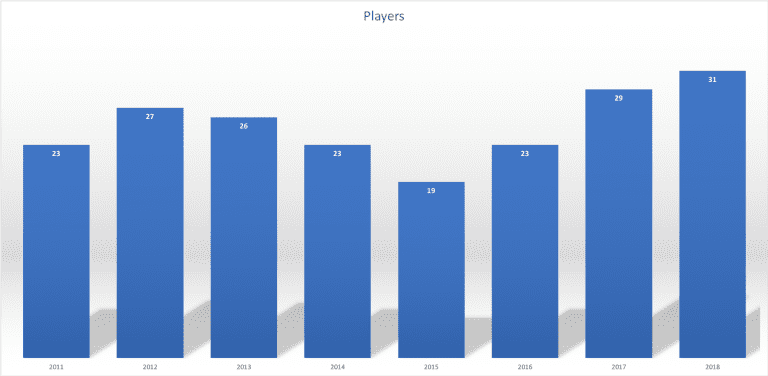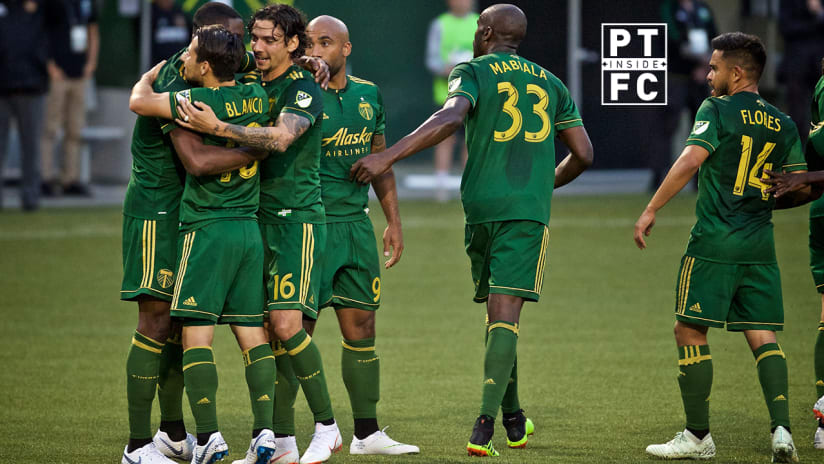“Every player in this squad can play in the first XI.”
We’ve heard language like this all season long from Portland Timbers head coach Giovanni Savarese, only this time, the words weren't coming from the first-year boss. It was one of his players, defender Larrys Mabiala – the only Timbers player who has played every Major League Soccer minute, this season – while talking about the pressure starters feel from the next level of the roster.
“The fact that we have the pressure of the guys on the bench helps a lot,” he explained, “because we, as the starters, we know that we cannot afford to miss a game.”
It’s not about missing a game in terms of injury, or some other absence, although as some Timbers have found out, reclaiming a first XI place is not easy, no matter the reason you leave the lineup. But beyond fitness, there are a series of other reasons somebody lower on the depth chart could make up ground. Train poorly, lose focus, or let your attitude slip? They’re more things that could cause a shakeup in the squad.
“Something like that,” Mabiala conceded, expounding on his “miss a game” remark. “Everybody is just focused to give the maximum every game.”
In the wake of Sunday’s 1-1 draw in Atlanta, we talked about the squad’s depth in the abstract: how the trade of Darlington Nagbe changed the nature of the roster; and how that change helped facilitated a new ethos. Implicitly, you hear about that depth every Tuesday during his weekly press conference, when Savarese talks about the strengths of his team, a conversation that almost always goes back to mentality and competition.
“Right now, I can see guys who, whoever steps on the field, they do the job,” Savarese said, seven days ago. “They battle one another in practice to get on the field, so I’m very happy we’ve achieve that part, which was one of our priorities at the beginning of the season.”
Within the context of the Timbers, it’s become impossible to disentangle one concept from the other, since it’s depth that allows a coach’s quest for competition to be acted on. It would be one thing to say, “I want everybody to compete, every day,” but when the weekend comes and decisions have to be made, you still have to do what’s best for the team. If, because of a lack of depth, the best team is still made up players who haven’t been pushed in the leadup, you don’t have true competition within a squad.
All of which is straight forward enough. What isn’t so straight forward is the proof behind this theory. After all, it’s one thing to say “the team is deeper” – a subjective judgment that can’t really be proven – but it’s another thing to say that depth is both manifesting on the field and changing the way the squad operates.
On that last point, we’ll have to take Mabiala’s (and others’) word for it, but we sure can check the other factor, the manifesting part, against actual data. In theory, if Portland’s team was truly deeper and that depth was being used, we should see a wider array of players getting playing time. We would be able to compare this to the team’s previous seasons and say, yes, the team is obviously using more players … right?
Right:

What you’re looking at here is how many distinct players appeared for the Timbers in all competitive games over the first 16 matches of each season. As you can see, Savarese has set a record this year, putting the club over the 30-player mark for the first time while increasing on the totals we saw in the middle of the Caleb Porter years, 2014 through 2016.
This season’s totally isn’t much of an increase on last year’s, though, mostly because of how last year’s Timbers approached the U.S. Open Cup. In the team’s 2-1 loss to Seattle Sounders FC in 2017, T2 players like Omar Mohamed, Russell Cicerone, and Villyan Bijev saw their only action of the season, joining more recognized Timbers names like Andre Lewis, Lamar Batista and Augustine Williamsin what was something beyond a second-choice squad. Not even players like Zarek Valentin, Marco Farfan, or Dairon Asprilla – part-time starters over the first part of last season – saw minutes at Starfire Sports.
It feels like, when talking about the first team’s depth, we should have a way to tease those one-offs out. After all, if the goal is to use lineup choices to assess the depth of a first-team squad, counting players who never, truly, impacted that first team squad feels off. In the vein, if you count up the number of players who made at least two starts in competitive games through the first 16 matches of a season, the Timbers have already used 21 players. Last year, that number was only 17.
That difference of four players may not seem like much, but those are players who’ve been chosen as starters, multiple times. That’s a 23.5 percent increase in options over the course of one offseason, and in the Targeted Allocation Money era, those players are unlikely to be back-of-the-roster options. They’re going to be the Samuel Armentoses, Julio Cascantes,Cristhian Paredes and Andy Polos of the world. To, coincidentally, name four.
It’s an increase that hasn’t been fueled by injury, players leaving the club, or not wanting to expose a first or second team to the Open Cup. It’s born of tactical flexibility. It’s born of options. It’s born of competition. It’s born of a new ethos.
It’s also could just be part of the natural maturation of an organization. Over the last seven-plus seasons, the Timbers have undoubtedly improved how they manage their resources, not only in terms of things like Allocation Money and international spots but also in scouting budgets, time devoted (or, not devoted) to certain agents, bringing on and developing staff with different knowledge bases as well as knowing where, across the world, they’re most likely to find the best talent. In 2018, the Timbers should be better at things than they were in 2011.
In that way, the depth at Saverese’s disposal may be part of a natural evolution, even if how he uses that depth seems very individual. Look around MLS, and you see other coaches preach competition, but you see fewer walk that walk. You see even fewer using their options as a way to be tactically unpredictable, and perhaps fewer still who are willing to make tough calls with some of the established names in their squads.
For much of the season, the virtues of depth, competition and mentality may have seemed like fortune cookie coaching. Now, amid an 11-game unbeaten run, they look like part of concerted formula. Where that formula leads come fall will define the 2018 season, but for now, that new ethos has the season back on course.












